|
|
|
Myanmar Office |
|
|
|
|
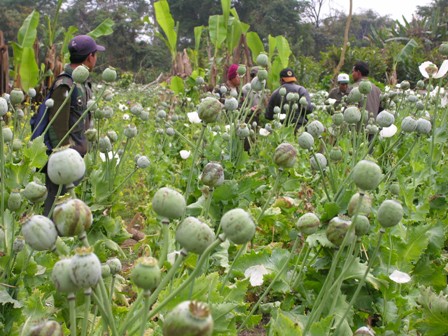
Drug Control in Myanmar
Myanmar is one of the first countries in the South East Asian Region that signed the UN Single Convention on Narcotic Drugs of 1961.
Following the invitation by the Government, a United Nations Preliminary Joint Survey Team, in 1964, visited the country to survey the economic and social needs of the opium producing regions. The prohibition of the sales of opium in the Shan State became effective from 1 October 1965.
In February 1974, the Government promulgated a new Narcotics Law imposing a ban on the cultivation of illicit narcotic crops, provided for the compulsory registration and treatment of drug addicts and heavy penalties for illicit cultivation, manufacture, possession, consumption and trafficking in narcotic drugs.
UNFDAC and Myanmar
In 1972, the Chairman and Secretary of the International Narcotics Control Board (INCB) and the Special Representative of the Secretary-General in charge of the United Nations Fund for Drug Abuse Control (UNFDAC) visited Myanmar to ascertain how the United Nations might assist governmental efforts to control drug abuse.
Four years later, in May 1976, Phase I of the UN/Burma Programme for Drug Abuse Control was finally signed. The US$ 6.5m programme was nation-wide in scope and covered activities in the fields of agriculture, livestock breeding for the purpose of income substitution, preventive education in schools, public information, and treatment and rehabilitation of addicts and law enforcement.
In February 1981 a multi-Agency Project formulation Mission visited Myanmar at the invitation of the Government to design the programme and drew up the Phase II - UNFDAC/Burma Programme for Drug Abuse Control. The US$ 5.4m Programme started in 1981 with a 5-year duration. The third Phase of the Programme was signed on 12 June 1986 and it included one new objective under the Law Enforcement Sector.
Yet, Due to the political situation in the country, UNFDAC's activities in Myanmar proceeded on a limited scale by mid 1988. The agreements reached with several ethnic insurgent groups in 1989 and further groups in subsequent years, allowed the Government to begin social and economic development programmes in border areas.
As a result of a new strategy to reverse the existing trend in illicit drug production, trafficking and consumption, UNFDAC was replaced by the United Nations International Drug Control Programme (UNDCP), established in 1991 pursuant to General Assembly resolution 45/179 of 21 December 1990.
Myanmar's internal situation, paving the way forward
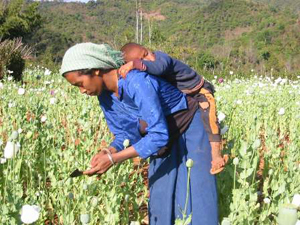 The Ministry of Border Areas and National Races and Development Affairs (PBANRDA) was established in 1992 and developed a Masterplan for border area development involving all the main line ministries. Two strategies were laid down to address the country's drug problems: firstly, to designate the elimination of narcotic drugs as a national duty; secondly, to eradicate the practice of opium poppy cultivation, while improving the social and economic life of the national groups in border areas.
The Ministry of Border Areas and National Races and Development Affairs (PBANRDA) was established in 1992 and developed a Masterplan for border area development involving all the main line ministries. Two strategies were laid down to address the country's drug problems: firstly, to designate the elimination of narcotic drugs as a national duty; secondly, to eradicate the practice of opium poppy cultivation, while improving the social and economic life of the national groups in border areas.
Through consultations with China, Myanmar and Thailand, UNDCP supervised in 1991 the developemtn of joint projects combining law enforcement, demand reduction and crop substitution in border areas.
A Memorandum of Understanding (MOU) was signed by the Governments of China, Laos, Myanmar and Thailand and the UNDCP in 1993 and all parties agreed to collaborate in drug control. Expansion of the 'membership' of the MOU to include Cambodia and Vietnam took place at a Ministerial Meeting held in Beijing in May 1995. The Meeting also approved a Sub regional Action Plan prepared by UNDCP and the six Governments.
Drug Demand Reduction Projects
Between 1993 and 1996 UNDCP implemented a demand reduction sub-project to develop preventive drug education activities along the common border areas of Myanmar and China.
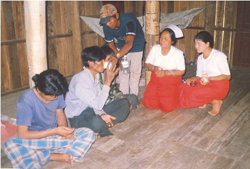 In October 1995, in partnership with the Governments of Myanmar and Thailand, UNDCP started a project aimed at the reduction in the demand for narcotics and for the very first time - prevention of HIV infection in specific border areas. The first injecting drug users related Project started in March 1998 and ended in December 2000. New approaches like Participatory Learning Appraisal (PLA) by the community and Stepping Stones - a gateway for ex users and addicts to seek assistance - were the project's highlights.
In October 1995, in partnership with the Governments of Myanmar and Thailand, UNDCP started a project aimed at the reduction in the demand for narcotics and for the very first time - prevention of HIV infection in specific border areas. The first injecting drug users related Project started in March 1998 and ended in December 2000. New approaches like Participatory Learning Appraisal (PLA) by the community and Stepping Stones - a gateway for ex users and addicts to seek assistance - were the project's highlights.
As one of the 6 MoU countries, Myanmar participated to the Project for Reducing Illicit Drug use in the Highlands of East Asia. Through participatory community-based demand reduction and social development activities this project aimed at reducing illicit drug use and related social problems in selected highland communities of East Asia. Seven Project sites in the northern Shan and Kachin were selected in Myanmar. The duration of the project was from September 1996 to December 1999 and was extended up to June 2000.
Within the MOU framework, other projects were developed such as Improvement of Drug Abuse Data Collection Systems and Subregional Development of Institutional Capacity for Demand Reduction Among High Risk Groups.
Drugs and HIV/AIDS Projects from 2000 to date
Through the experience gained and lessons learned from the sub regional Highland Project, the UNODC Country Office in Myanmar (COMYA) formulated a Community based DDR Project in three key townships in the northern Shan State covering 30 villages with activities such as advocacy, drug prevention education, community-based treatment and rehabilitation, drugs and HIV/AIDS awareness, gender, micro-credit for the women in the communities, empowerment of women, etc. Simultaneously, UNODC, with the assistance from UNAIDS, trained Police Officers at the Academy and the
Police Training Institutes in drugs and HIV/AIDS-related legal issues. The Implementing Partner of the Project was
CARE Myanmar.
The EC funded Project
Reducing injecting drug use and its harmful consequences in Union of Myanmar covered the same areas in the northern Shan State and Kachin State during the Phase I with INGO Partners such as CARE Myanmar and
Medicine du Monde working closely with UNODC. One of the highlights of the Project was that UNODC was permitted to train not only the Prison Staff but also inmates in drugs and HIV/AIDS prevention in 30 Prisons and Camps.
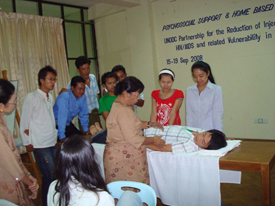 Within the framework of the Fund for HIV/AIDS in Myanmar (FHAM), UNODC was responsible for the set up of a
Technical Coordination Unit, to coordinate all partners working in the field of HIV/AIDS. Although the Project completed its formal term in May 2007, the activities continued without any interruption, with a new set up as formulated in the 3 Disease Fund (3DF) Project. This project is implemented in partnership with Township Project Management Committees, INGO, NGO and Community Based Organizations (CBOs) to provide prevention activities, basic health care services, distribution of infection containment materials to injecting drug users (IDUs), their partners and families via drop-in-centres and outreach activities. The activities of outreach projects are linked with referral services to drug treatment and methadone maintenance activities where possible.
Within the framework of the Fund for HIV/AIDS in Myanmar (FHAM), UNODC was responsible for the set up of a
Technical Coordination Unit, to coordinate all partners working in the field of HIV/AIDS. Although the Project completed its formal term in May 2007, the activities continued without any interruption, with a new set up as formulated in the 3 Disease Fund (3DF) Project. This project is implemented in partnership with Township Project Management Committees, INGO, NGO and Community Based Organizations (CBOs) to provide prevention activities, basic health care services, distribution of infection containment materials to injecting drug users (IDUs), their partners and families via drop-in-centres and outreach activities. The activities of outreach projects are linked with referral services to drug treatment and methadone maintenance activities where possible.
Since January 2008, UNODC is engaged in the implementation of the project
Reducing the spread of HIV/AIDS among injecting drug users through the HAARP Country Flexible Programme in Myanmar. The Project has a strong advocacy component to influence government counterpart to support drug-related national programs.
Alternative Development and Sustainable Livelihoods Projects from 1995 to date
The first project in the area of Alternative Development involving UNDCP was developed in 1994/1995 in Southern Wa Region. Subsequently two more projects were conducted in Wa Special Region and Shan State. Both Projects were implemented from 1998 to 2000 and the activities included assistance to the communities through clean water supply, construction of channels, assistance to hospitals and schools in the target areas.
In 1998 UNODC started a 10 year Project -
Drug Control and Development in the Wa Region of Shan State with the aim of establishing a sustainable community based approach to the reduction and eventual elimination of supply of and demand for opium in the Wa Region.
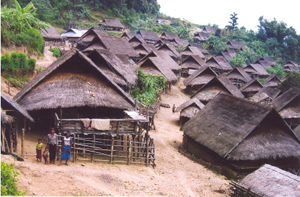 Myanmar is one of the participating countries to the
Global Partnership on Alternative Development Project which promotes Sustainable Livelihoods in several countries including Lao PDR and Myanmar from Asia; Bolivia, Colombia and Peru from Latin America.
Myanmar is one of the participating countries to the
Global Partnership on Alternative Development Project which promotes Sustainable Livelihoods in several countries including Lao PDR and Myanmar from Asia; Bolivia, Colombia and Peru from Latin America.
UNODC is currently engaged in the project
Illicit Crop Monitoring Project to conduct annual crop monitoring activities - in the target areas of Shan, Kachin and Kayah States - in close cooperation with the Government counterpart agency, the
Central Committee for Drug Abuse Control and the Forestry Department. Annual surveys are conducted from November to March and Off Season surveys in September.